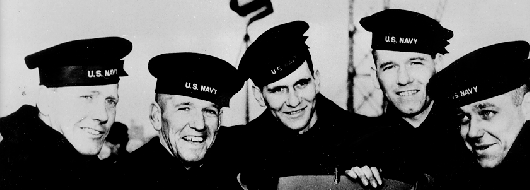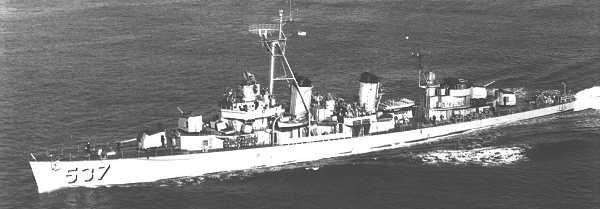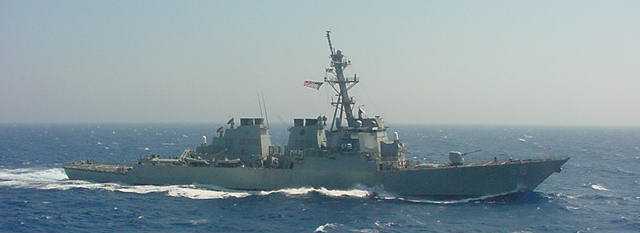Monday Maritime Matters
August 13th, 2007 by xformed

- Sullivan, Albert Leo, Seaman Second Class, V-6, USNR; 1-3-1942 Enlisted in the U.S. Naval Reserve, Class V-6, as Apprentice Seaman to serve for two (2) years at the Naval Recruiting Station, Des Moines, Iowa
- Francis Henry Sullivan, Coxswain, V-6, USNR; 5-11-1937 Enlisted in the U.S. Navy as Apprentice Seaman, to serve for four (4) years at the Navy Recruiting Station, Des Moines, Iowa and transferred to the Naval Training Station, San Diego, California, for recruit training.
- SULLIVAN, George Thomas, Gunner’s Mate Second Class, V-6, USNR; 5-11-1937 Enlisted in the U.S. Navy as Apprentice Seaman, to serve for four (4) years at the Navy Recruiting Station, Des Moines, Iowa and transferred to the Naval Training Station, San Diego, California, for recruit training.
- SULLIVAN, Joseph Eugene, Seaman Second Class, V-6, USNR; 1-3-1942 Enlisted in the U.S. Naval Reserve, Class V-6, as Apprentice Seaman to serve for two (2) years at the Naval Recruiting Station, Des Moines, Iowa.
- SULLIVAN, Madison Abel, Seaman Second Class, V-6, USNR; 1-3-1942 Enlisted in the U.S. Naval Reserve, Class V-6, as Apprentice Seaman to serve for two (2) years at the Naval Recruiting Station, Des Moines, Iowa.
From Castletown.com:
The Sullivan family led lives much like other middle class families of the 1920s and 1930s. It was Depression time and Tom Sullivan was fortunate that he had a job. Not all of his children were able to finish high school. A few of the boys found it necessary to help out meeting the household expenses. The vacant lot next to their home provided space for various sports activities. Most of the family found work at the Rath meat packing plant. When the two oldest, George and Frank, returned home from a hitch in the Navy, all five Sullivan brothers were working together again, just as they were when playing sports on that lot next door to their home. The youngest, Albert was the first to get married. He and his wife Mary became parents when their son, James Thomas, was born on May 11, 1940. The other brothers would probably have done the same, but World War II got in the way. When reports were received about the death of their friend, Bill Ball, who was on the battleship Arizona when the Japanese attacked Pearl Harbor, they decided to enlist in the Navy. They did insist, however, that the Navy allow them to stay together throughout their service. The Navy agreed. On January 3, 1942, less than a month after Pearl Harbor, they were sworn in at Des Moines, and left for Great Lakes Training Center.
The five sons of the family all ended up stationed on the USS JUNEAU (CL-52), reporting aboard together on 02/03/1942, just 11 days before commissioning of this new ship in New York. The USS JUNEAU (CL-52) sailed to the South Pacific, after a hurried shakedown period in the Atlantic, where she was operating near the Solomon Islands, in support of the landing at Guadalcanal on November 12th, 1942:
From Wikipedia:
[..]
On 8 November Juneau departed Nouméa, New Caledonia, as a unit of Task Force 67 under the command of Rear Admiral R. K. Turner to escort reinforcements to Guadalcanal. The force arrived there early morning 12 November, and Juneau took up her station in the protective screen around the transports and cargo vessels. Unloading proceeded unmolested until 1405 when 30 Japanese planes attacked the alerted United States group. The AA fire was effective, and Juneau alone accounted for six enemy torpedo planes shot down. The few remaining attackers were then attacked by American fighters; only one bomber escaped. Later in the day an American attack group of cruisers and destroyers cleared Guadalcanal on reports that a large enemy surface force was headed for the island. At 0148 on 13 November Rear Admiral D. J. Callaghan’s relatively small Landing Support Group engaged the enemy. The Japanese force consisted of two battleships, one light cruiser, and nine destroyers.
[…]
From Castletown.com:
On the evening of November 12th, air reconnaissance discovered the approach of the Japanese task force. It was considerably larger than the American force. The transports fled and the warships prepared for the coming battle. Despite having radar, the American ships almost collided with those of the enemy. The engagement began about 1:45 A.M. There was no moon that night and there was instant chaos as searchlights suddenly illuminated the two adversaries at close range to one another. All ships unleashed their barrage of heavy armaments at point blank range. Within 30 minutes the engagement was essentially over. The Japanese lost a battleship and two destroyers. Five of the 13 U.S. ships had been sunk or were heavily damaged. Many men were lost, including the task force commander, Rear Admiral Callaghan. The Juneau had just barely survived, having received a torpedo hit on it’s port side which left a gaping hole and an almost severed keel.
[..]
At daybreak the surviving American ships huddled together and headed back to their base. Late that morning, a torpedo fired from a Japanese submarine, struck the Juneau near the storage area of its ammunition supply. “When the torpedo hit, there was a single explosion and the air was filled with debris, much of it in large pieces. The whole ship disappeared in a large cloud of black, yellow black, and brown smoke. Debris showered down among ships of the formation for several minutes after the explosion to such an extent as to indicate erroneously, a high level bombing attack.†Thus Captain Gilbert, the acting Commander of the task force, described what he saw when the U.S.S. Juneau was struck. The captain of the U.S.S. San Francisco, H.E. Shonland, reported that: “It is certain that all on board perished.†Captain Hoover decided that rather than delay the escape of the other ships, he would request that an Army aircraft in the area report the position of the Juneau. The pilot did send in a report but it did not get to the proper authorities. And, even more tragically, Captain Shonland was wrong — there were survivors from the Juneau. It was not known exactly how many made it into life rafts; there were at least 80. Among them was George Sullivan, the oldest brother.Gunner’s mate Allen Heyn was one of the survivors that was finally rescued from the sinking of the Juneau. He reported that there were 10 days of intense suffering as, one by one, the men succumbed to the intense heat, their wounds, and sharks. Many were badly burned and died a painful death. They became delirious from hunger and thirst. Heyn recalled how George Sullivan decided to take a bath one night. He took off all his clothes and swam around the raft. His movement attracted a shark…and that was the last Heyn saw of him. Only ten men survived the ordeal.
The US Navy too the issue of family members seriously after this incident and prohibited such stationing together. Some history of this outcome is here.
Two ships have been named to honor the five Sullivan brothers: DD-573 and DDG-68. THe first USS THE SULLIVANS (DD-537) is a museum ship in the Great Lakes at Buffalo, NY, berthed with the USS LITTLE ROCK (CLG-4).

DD-537, of the FLETCHER Class, was commissioned 9/30/1943. She served through the many historical battles of the Pacific, earning 9 Battle Stars. Following WWII, THE SULLIVANS participated in the Korean War, conducting gunfire support operations. The USS THE SULLIVANS was later used as a “school ship” for Officer training in Newport, RI, before being transfered to New York City in the Naval Reserve. She was decommissioned 1/7/1965. The link at the beginning of this paragraph contains some very detailed accounts of the WWII actions, and a not of her patrols to try to locate the USS THRESHER (SSN-593) in April, 1963.

The motto of the current USS THE SULLIVANS is the motto of the Sullivans Brothers: “We stick together!”
Category: Maritime Matters, Military, Military History, Navy | 2 Comments »